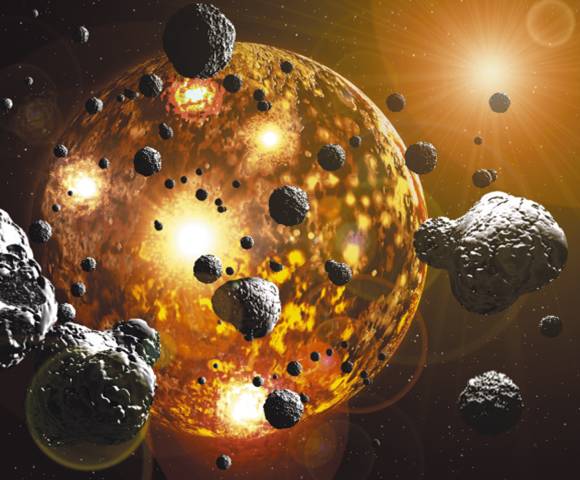Most of the bling with which we bedeck ourselves arrived on Earth aboard  meteorites, recent research has revealed.
meteorites, recent research has revealed.
Our planet's early existence 4.5 billion years ago was a tempestuous one. Frequent massive collisions occurred between the proto-Earth and Moon- and Mars-sized objects that were accreting alongside our world from the disk of dust that spawned the solar system.
The energy of these impacts caused the Earth literally to melt. Inside the resulting giant molten ball, the heavy elements, like iron, sank towards the centre where they would later form what is now the planet's core. The lighter silicates then floated to the top like a cappuccino froth.
But therein lies the wrinkle, because heavy elements like gold and platinum are what are known as siderophiles. They readily combine with iron and therefore should have been pulled down into the core when the iron sank to the centre when the Earth was molten. Instead, these precious metals are actually about 1% more abundant in the Earth's outer layers than they ought to be.
One theory is that, at the very high pressures like those encountered within the planet's interior, the iron somehow releases its grip on the precious metals and they are squeezed out towards the surface. But whilst plausible, this explanation works for only certain elements so cannot be the whole story.
Now, by locating a geological needle in a haystack, scientists at the University of Bristol have found evidence to support a more elegant solution - that the Earth's gold-robbed surface was re-charged with the metal by a later, intense meteor shower after the planet had cooled.
Matthias Willbold and his colleagues, who have published the findings in Nature, reasoned that, when the Earth was molten, the element tungsten would have moved into the iron core, alongside the gold, leaving the planet's mantle relatively depleted in tungsten and enriched for another silicate-preferring element called hafnium-182. But hafnium-182 decays radioactively into tungsten-182. Therefore, the Earth's surface should have a relatively higher level of tungsten-182 than any meteorites that arrive later. So if rocks could be found from the early Earth that bear the predicted level of tungsten-182, this would support the hypothesis that the Earth was largely later re-surfaced by a batch of big meteorites, which would also have contained gold and other precious metals.
Incredibly, the team were able to locate such a set of samples. Rocks dating back 3.8 billion years, from Isua in Greenland, were a direct isotopic match.
"This strongly supports the depositing of a 'late veneer' of material added to the Earth's surface during a 500 million year phase called 'the late heavy bombardment'," says Willbold. "Some very large impactors struck the planet and re-coated the surface..but luckily in the case of these rocks in Greenland, not everywhere..."










Comments
Add a comment